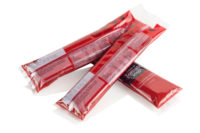
|
| The inks and coatings used to print labels on flexible packaging can be as varied as the labels and packaging themselves, ranging in print method, ink type and performance requirements. |
A label can be as simple as a single-color, surface-print sticker. It can also be as sophisticated as a high-definition, personal-care label featuring multiple print methods and specialty inks. The inks that are used to produce these labels are as varied as the labels themselves, ranging in print method, ink type and performance requirements.
Inks and Processes for Label Printing
The most commonly used inks for label printing are solvent-based, water-based and UV. These inks can be used for a variety of the more common printing processes used for label printing, including: UV flexo, solvent gravure, UV rotary screen, UV litho or letterpress, and various types of digital printing.
Each type of ink and printing process has inherent advantages associated with it. For instance, UV-curable inks and coatings have excellent chemical and heat resistance because they are cured by a crosslinking process.
Similarly, solvent-based inks are usually the best choice for adhesion to films, in part because of their solvent content and resulting low surface tension. Gravure printing is most commonly used for long runs, and digital printing can be used to produce labels with multiple variations within a single, relatively short run.
Even though there can be clear favorites in each category, each type of ink comprises a wide performance window, and there is often significant overlap in capabilities from one process to another. This means that most inks and print methods can be used for most label applications.
Labels vs. Flexible Packaging
Flexible packaging is dominated by solvent-gravure, solvent-flexo, and water-flexo printing. It is printed primarily on film and foil. There is relatively little UV flexo used for flexible packaging.
Like flexible packaging, labels are also printed primarily with flexographic inks. Gravure and offset are also commonly used to produce labels on wide web presses. Substrates include films, foils, and paper, and the use of UV-curable inks and coatings is common for many applications.
Combination printing is also popular in the world of labels, especially for the personal care market. This approach usually pairs a print method that can apply a relatively thick layer of ink, such as UV screen, gravure, or high-volume anilox flexo, with a second print method that can produce fine graphics, such as process flexo or litho.
This method lends itself well to the application of opaque white or specialty products such as metallics, fluorescents, or tactile effect coatings – all of which require heavier application weights to achieve their full effect, while simultaneously delivering high quality and detailed graphics on a single label with only a single pass through the press.
Narrow Web vs. Wide Web Labels
There are differences in the choice of print processes between wide-web and narrow-web label production. In narrow web, other methods besides flexography are common, and the use of gravure is relatively rare, with some notable exceptions. One of the alternative print methods used for narrow web label production is digital printing with liquid toners, dry toners, or liquid inkjet inks and their associated processes.
Digital printing is used as a standalone production process for short runs and fully customized labels, and it can be integrated with more conventional label-printing methods as a sort of conversion process, including customizing individual pre-printed labels at the end of the press.
While the same types of ink can be used for both narrow-web and wide-web applications, they are usually optimized for each process, rather than using exactly the same formulas for both press types.
Wide web presses are designed for high throughput, and can run up to and over 2,000 feet per minute. This requires fast-drying inks. Narrow web presses typically run anywhere from 150-800 feet per minute, so they need slower-drying inks. In-line conversion processes, such as die cutting, foil stamping and embossing, also fit better with the production speeds of narrow web.
Inks are usually supplied press-ready to narrow-web printers; wide-web printers generally assemble their own from individual components on a dispenser and adjust formulas on site to their preferred viscosity and drying speed before putting them on press.
Unlike wide-web labels, many narrow-web labels are produced with at least one type of UV-curable ink or coating. For narrow web printing, the convenience and versatility of UV-curable inks justify their higher cost. UV screen, UV litho or letterpress, and especially UV flexo inks are commonly used.
In addition, UV coatings are often used over surface print labels to impart extra gloss or durability, even if the ink technology underneath is not also UV-curable.
Conclusion
The field of label inks continues to grow and become more diverse. New opportunities and challenges abound for more customization, more sustainable offerings and always more ways to add value to the labeled product.
The fact that labels can be produced by every major print method in existence means that label printers can continually benefit from the best advances in ink and print technology to meet and exceed these challenges.



